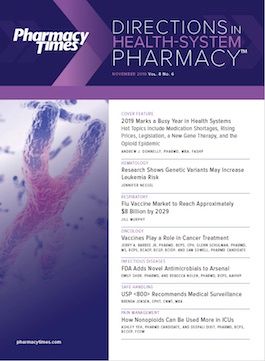USP Recommends Medical Surveillance
Those who handle hazardous drugs on a regular basis should follow steps to minimize exposure.
United States Pharmacopeia (USP) Chapter <800> (“HAZARDOUS DRUGS— HANDLING IN HEALTHCARE SETTINGS”) describes standards for the safe handling of hazardous drugs (HDs) that include use of engineering controls, personal protective equipment (PPE), and safe work practices.
Medical surveillance is recommended for workers who routinely handle HDs because it may lead to early detection of health problems caused by exposure to these agents. It may also help uncover issues within a facility, such as inadequate procedures for handling HDs or lack of compliance to established procedures, ineffective or misused engineering controls or PPE, or weaknesses in employee training programs. The primary purpose of medical surveillance is to minimize adverse health effects from exposure to HDs.
USP <800> states that a medical surveillance program should include the following:
- Completion of an exit examination when a worker’ s employment ends, documenting the information on the employee’ s exposure, medical, and reproductive history. Examination and laboratory evaluation should be guided by the individual’s history of exposures and follow the outline of the periodic evaluation.
- Development of a follow-up for workers who have shown health changes suggesting toxicity or experienced an acute exposure. This plan should include evaluation of administrative and engineering controls and equipment to ensure that all systems are accurately and appropriately implemented.
- Development of an organized approach to identify workers who are potentially exposed to HDs on the basis of their duties
- Initial baseline assessment (preplacement) of a worker’s health status and medical history. Data elements collected include a medical history, including reproductive and work history, to assess exposure to HDs, laboratory testing, and physical examination.
Methods used to assess exposure history include a review of:
- Estimated number of HDs handled per week
- Estimated hours spent handling HDs per month and/or week
- Performance of a physical assessment and laboratory studies linked to target organs of commonly used HDs, such as a baseline complete blood count. Biological monitoring to determine blood or urine levels of specific HDs is not recommended in surveillance protocols but may have a role in the follow-up of acute spills with a specific agent.
- Records of HDs handled, with dosage forms and quantities
- Maintenance of medical records of surveillance according to Occupational Safety and Health Administration regulation concerning access to employee exposure and medical records
- Monitoring data to identify prevention failure leading to health effects; may occur in collaboration with the employee health service
- Monitoring workers’ health prospectively through periodic surveillance using the elements of data gathering described above
- Use of a contracted or entity-based employee health service to perform the medical surveillance while protecting confidentiality of the employees’ personal medical information
If an exposure-related health change does occur, USP <800> recommends the following actions:
- Compare performance of controls with recommended standards; conduct environmental sampling when analytical methods are available.
- Develop and document a plan of action to prevent additional exposure of workers.
- Ensure that any exposed worker receives confidential notification of any adverse health effect. Offer an alternative duty or temporary reassignment.
- Provide and document a follow-up medical survey to demonstrate the plan’s effectiveness.
- Perform a medical examination that is tailored to the type of exposure.
- Provide ongoing medical surveillance of all workers at risk of exposure to HDs to determine whether the plan implemented is effective.
- Verify and document that all engineering controls are in proper operating condition.
- Verify and document that the worker complied with existing policies. Review policies for the use of PPE and employee compliance with PPE policies and use. Review availability of appropriate PPE.
Medical surveillance programs track individual workers to determine if any health changes may be caused by exposure to HDs but may also help identify trends in large groups of workers, making it easier to correlate specific health changes with exposure to HDs and develop appropriate treatment plans. Identifying trends may also help pinpoint areas that need improvement in national standards related to employee training programs, engineering controls, PPE, and safe work practices related to handling HDs to, hopefully, limit the number of people negatively affected in the future.

